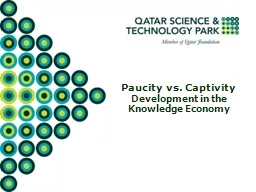

Development in the Knowledge Economy The total value of real estate not legally owned by the poor of the Third World and former communist nations is at least 93 trillion about twice as much as the total circulating US money supply and nearly as much as the total value of all the companies ID: 361851
Download Presentation The PPT/PDF document "Paucity vs. Captivity" is the property of its rightful owner. Permission is granted to download and print the materials on this web site for personal, non-commercial use only, and to display it on your personal computer provided you do not modify the materials and that you retain all copyright notices contained in the materials. By downloading content from our website, you accept the terms of this agreement.
Slide1
Paucity vs. Captivity
Development in the Knowledge EconomySlide2
The total value of real estate not legally owned by the poor of the Third World and former communist nations is at least $9,3 trillion... about twice as much as the total circulating US money supply... and nearly as much as the total value of all the companies listed on the main stock exchanges of the world’s twenty most developed countries... twenty times the total direct foreign investment into all Third World and former communist countries in the ten years after 1989… forty-six times as much as all the World Bank loans of the past three decades, and ninety-three times as much as all development assistance from all advanced countries to the Third World in the same period.
- Hernando de Soto,
The Mystery of Capital
The role of property and capital in wealth creationSlide3
[LDCs] hold resources in defective forms: houses built on land whose ownership rights are not adequately recorded, unincorporated businesses with undefined liability, industries located where financiers and investors cannot see them. Because the rights to these possessions are not adequately documented, these assets cannot be traded into capital, cannot be traded outside of narrow circles where people know and trust each other, cannot be used as collateral for a loan and cannot be used as a share against an investment.
- Hernando de Soto,
The Mystery of Capital
The role of property and capital in wealth creationSlide4
A
C
P
Assets as valuable objects
Property as objects for commercial transactions
Capital as objects in an machinery for creation of wealth
Using the concepts of assets, property and capital
Source: CIP
Slide5
5
Capital Management
-Define, value, claim, manage new ideas & knowledge as objects in a financial machinery
Securitization & management of IP as collateral
Controlling, accounting & taxation
Governance of bankruptcy estates, etc
Property Management
-Define, value, claim, manage new ideas as value propositions
IPR management
License management
Management of virtual products
Standardization management
Open source management, etc
Asset Management
-Define, value, claim, manage new ideas & knowledge as firm assets
R&D management
Open innovation management
Knowledge management
Information management, etc
Intellectual
Managing knowledge-based businessSlide6
IP from a knowledge economy perspective
New role of IPIP to build not block IP doesn’t block innovation, people doIP as the key to opennessThe knowledge economy is not about knowledge per se, but the control of knowledge
If knowledge is the new wealth of nations, access to knowledge will likely be seen as a human right
Welfare technologies (agriculture, water, environment, medicine, etc.)In the knowledge economy we are all developing countries
6